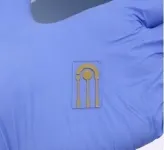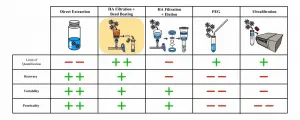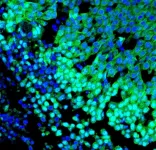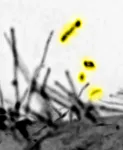Study could help develop biosensors for non-invasive diagnosis of diseases
Brazilian researchers tested the capacity of different materials to produce sensors for the detection of PCA3, a gene that is overexpressed in prostate cancer. The technique can also be used to diagnose infectious diseases, including COVID-19.
2021-03-22
(Press-News.org) The efficacy of biosensors used in clinical tests depends critically on the surface of the device on which the biorecognition molecules are immobilized. This surface can be adjusted and sometimes controlled using self-assembled molecular monolayers as matrices. The monolayers are films made up of organic molecules that under the right conditions assemble spontaneously on metal surfaces via chemical bonds between the sulfur atoms and the metal.
A study conducted at the University of São Paulo's São Carlos Physics Institute (IFSC-USP) in Brazil compared the performances of two types of self-assembled monolayers, one consisting of mercaptoacetic acid (MAA) in water and ethanol, and another of 11-mercaptoundecanoic acid (11-MUA) in ethanol. The respective films were evaluated in terms of their capacity to produce sensors for detection of the gene PCA3, which is specific to prostate cancer cells.
"We showed that efficient immobilization of a simple DNA strip to detect the gene PCA3 can be achieved even in less organized monolayers, provided the terminal groups are ionized," Paulo Augusto Raymundo Pereira, lead author of the study, told. An article reporting the findings is published in The Journal of Physical Chemistry C.
The study was supported by São Paulo Research Foundation - FAPESP via a postdoctoral fellowship awarded to Raymundo-Pereira, and a scholarship and a Regular Research Grant awarded to other participants. Another source of funding was the Thematic Project "Toward a convergence of technologies: from sensing and biosensing to information visualization and machine learning for data analysis in clinical diagnosis", led by Osvaldo Novais de Oliveira Junior, Raymundo-Pereira's research advisor.
"The study showed that the differences in performance between biosensors made with MAA film and 11-MUA film are not due solely to monolayer organization. Carboxylate group ionization is important. For this reason, it's necessary to know the right conditions for formation of the film with these characteristics," Raymundo-Pereira said.
Because MAA has proved promising for biosensor matrices, the comparison of the different preparation conditions investigated in the study can contribute to the production of high-quality films. "This knowledge can help construct other types of matrix prepared with monolayers," Raymundo-Pereira said. "It's now available to any researcher. As a side-effect, our own group has created another biosensor to detect the novel coronavirus."
He stressed the importance of constructing non-invasive biosensors, especially in light of the growing use of telemedicine during the pandemic because of social distancing. "In the diagnosis and monitoring of prostate cancer, which was our proof of concept, the standard procedure is to quantify the level of prostate-specific antigen or PSA," he said. "This entails taking a blood sample from the patient, which is an invasive procedure.
Moreover, the result isn't always conclusive as a large proportion of false-positives result from high levels of PSA associated with inflammation of the prostate, for example. In this case, the medical recommendation is biopsy, which is even more invasive. The antigen expressed by the gene PCA3 can be detected in urine by users of a biosensor that could be sold by drugstores."
"Both contributions of the study relate to more accurate diagnosis of prostate cancer and the possibility of replacing such detection methods as PCR (polymerase chain reaction), which is essential to diagnose not just cancer but also other diseases, including COVID-19," Oliveira Junior said.
INFORMATION:
Besides the IFSC-USP group, the study involved researchers at the Brazilian National Nanotechnology Laboratory (LNNano), run by the Brazilian Center for Research in Energy and Materials (CNPEM) in Campinas, in the state of São Paulo; Hospital de Amor in Barretos, also in São Paulo; and Instituto de Pesquisa Pelé Pequeno Príncipe in Curitiba, Paraná state.
About São Paulo Research Foundation (FAPESP)
The São Paulo Research Foundation (FAPESP) is a public institution with the mission of supporting scientific research in all fields of knowledge by awarding scholarships, fellowships and grants to investigators linked with higher education and research institutions in the State of São Paulo, Brazil. FAPESP is aware that the very best research can only be done by working with the best researchers internationally. Therefore, it has established partnerships with funding agencies, higher education, private companies, and research organizations in other countries known for the quality of their research and has been encouraging scientists funded by its grants to further develop their international collaboration. You can learn more about FAPESP at http://www.fapesp.br/en and visit FAPESP news agency at http://www.agencia.fapesp.br/en to keep updated with the latest scientific breakthroughs FAPESP helps achieve through its many programs, awards and research centers. You may also subscribe to FAPESP news agency at http://agencia.fapesp.br/subscribe.
[Attachments] See images for this press release:

ELSE PRESS RELEASES FROM THIS DATE:
2021-03-22
Myelodysplastic syndrome (MDS) is a disease of the stem cells in the bone marrow, which disturbs the maturing and differentiation of blood cells. Annually, some 200 Finns are diagnosed with MDS, which can develop into acute leukaemia. Globally, the incidence of MDS is 4 cases per 100,000 person years.
To diagnose MDS, a bone marrow sample is needed to also investigate genetic changes in bone marrow cells. The syndrome is classified into groups to determine the nature of the disorder in more detail.
In the study conducted at the University of Helsinki, microscopic images of MDS patients' bone marrow samples were examined utilising an image analysis technique based ...
2021-03-22
Greenwood, SC (March 22, 2021) - A research team at the Greenwood Genetic Center (GGC) has identified the mechanism that causes movement disorders in patients with mutations in the NUS1 gene. Using both cellular and model organism studies, cholesterol accumulation was found to contribute to the symptoms of seizures, ataxia, and movement abnormalities. This breakthrough study on NUS1, a gene that has also been potentially linked to Parkinson's Disease, is reported in the current issue of Genetics in Medicine, the Journal of the American College of Medical Genetics and Genomics.
Chloe Murphy, 15, of Bluffton, SC began experiencing tremors at age three. Through the years she has also experienced seizures, atypical eye movements, learning delays, ...
2021-03-22
Reston, VA--A new treatment for late-stage neuroendocrine tumors (NETs) has been found to be more effective and have fewer side effects than the current standard of care, according to research published in the March issue of The Journal of Nuclear Medicine. The novel peptide receptor radionuclide therapy holds promise to reduce mortality among NET patients and decrease the financial burden of their continual treatment.
NETs are a diverse group of tumors that originate from the neuroendocrine system, which is responsible for regulating hormones throughout the body. The number of people who are diagnosed with NETs is growing; the incidence of NETs increased 6.4-fold from 1973 to 2012. However, because they are rare, varied, ...
2021-03-22
HOUSTON - (March 22, 2021) - There are many ways to test municipal wastewater for signs of the virus that causes COVID-19, but scientists in Houston have determined theirs is the best yet.
A study led by environmental engineer Lauren Stadler of Rice University's Brown School of Engineering with the aid of the City of Houston Health Department and Baylor College of Medicine compared five processes used by labs around the country to concentrate samples and find the virus in wastewater from six Houston plants.
The process employed at Rice and now Baylor, called "electronegative filtration with bead beating," proved the most sensitive to signs of the virus as well as the most cost-effective.
The study appears in the Elsevier journal Water Research.
There ...
2021-03-22
Breast cancer is the most common type of tumour found in women. 69,000 new cases are diagnosed each year in Germany alone. Around 80 percent of tumours originate in the luminal cells, the milk-producing cells of the mammary gland. 10 percent of the cells resemble those of the underlying (basal) cell layer. These are muscle-like epithelial cells that contract when the mammary gland produces milk in order to push it out.
"While luminal breast tumours are usually sensitive to hormones, 80 percent of basal-like tumours are triple-negative. They have no receptors ...
2021-03-22
Scientists from the University of Leeds's Nutritional Epidemiology Group used data from 500,000 people, discovering that consuming a 25g serving of processed meat a day, the equivalent to one rasher of bacon, is associated with a 44% increased risk of developing the disease.
But their findings also show eating some unprocessed red meat, such as beef, pork or veal, could be protective, as people who consumed 50g a day were 19% less likely to develop dementia.
The researchers were exploring a potential link between consumption of meat and the development of dementia, a health condition that affects 5%-8% of over 60s worldwide.
Their results, titled Meat consumption and risk of incident dementia: cohort study of 493888 UK Biobank participants, ...
2021-03-22
Ikoma, Japan - What if you found out that you could heal using only a finger? It sounds like science fiction, reminiscent of the 1982 movie E.T. Well, it turns out that your body's own cells can do something similarly unexpected. Researchers at Nara Institute of Science and Technology (NAIST) report in a new study seen in Developmental Cell a means by which cells may use "fingers" to communicate instructions for wound closure.
NAIST project leader Shiro Suetsugu has devoted his career to studying how cells shape themselves, initiate and accept communication among one other. An under-appreciated means of doing so is through filopodia, small finger-like ...
2021-03-22
WHAT:
Children in high-poverty neighborhoods who participated in a comprehensive preschool program that provided parents with health and educational services and job training had a lower body mass index (BMI) in their late 30s than a similar group who participated in the usual early childhood programs, according to a study funded by the National Institutes of Health. The study authors concluded that comprehensive, school-based early childhood programs could lead to improvements in body mass index later in life. The study was conducted by Arthur J. Reynolds, Ph.D., of the University of Minnesota, and colleagues. It appears in JAMA Pediatrics. ...
2021-03-22
What The Study Did: This study examined whether the quantity and quality of antibodies against SARS-CoV-2 were different among children, adolescents and young adults.
Authors: Zhen Zhao, Ph.D., of Weill Cornell Medicine in New York, is the corresponding author.
To access the embargoed study: Visit our For The Media website at this link https://media.jamanetwork.com/
(doi:10.1001/jamanetworkopen.2021.4302)
Editor's Note: The article includes conflict of interest and funding support disclosures. Please see the article for additional information, including other authors, author contributions and affiliations, conflict of interest and financial disclosures, and funding and support.
INFORMATION:
Media ...
2021-03-22
What The Study Did: Researchers investigated whether shelter-in-place orders in the United States during the early weeks of the COVID-19 pandemic were associated with changes in body weight among adults.
Authors: Gregory M. Marcus, M.D., M.A.S., of the University of California, San Francisco, is the corresponding author.
To access the embargoed study: Visit our For The Media website at this link https://media.jamanetwork.com/
(doi:10.1001/jamanetworkopen.2021.2536)
Editor's Note: Please see the article for additional information, including other authors, author contributions ...
LAST 30 PRESS RELEASES:
[Press-News.org] Study could help develop biosensors for non-invasive diagnosis of diseases
Brazilian researchers tested the capacity of different materials to produce sensors for the detection of PCA3, a gene that is overexpressed in prostate cancer. The technique can also be used to diagnose infectious diseases, including COVID-19.




